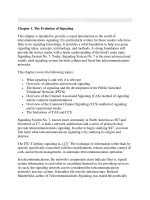ns-2 Tutorial (1) pps
Bạn đang xem bản rút gọn của tài liệu. Xem và tải ngay bản đầy đủ của tài liệu tại đây (516.68 KB, 16 trang )
1
Jianping Wang, 2004 cs757 1
ns-2 Tutorial (1)
Multimedia Networking Group,
The Department of Computer Science, UVA
Jianping Wang
Jianping Wang, 2004 cs757 2
Contents:
• Objectives of this week
• What is ns-2?
• Working with ns-2
• Tutorial exercise
• ns-2 internals
• Extending ns-2
Today
Partly adopted from Nicolas’ slides.
2
Jianping Wang, 2004 cs757 3
Objectives of this week
• Get some exposure to one of the most useful tools in
networking research and development.
• Understand and work with a popular network
simulator.
• Get a better understanding of the networking
dynamics.
• “Smooth the learning curve”.
Jianping Wang, 2004 cs757 4
What is ns-2?
• ns-2 stands for Network Simulator version 2.
• ns-2:
• Is a discrete event simulator for networking research
• Work at packet level.
• Provide substantial support to simulate bunch of
protocols like TCP, UDP, FTP, HTTP and DSR.
• Simulate wired and wireless network.
• Is primarily Unix based.
• Use TCL as its scripting language.
• ns-2 is a standard experiment environment in
research community.
3
Jianping Wang, 2004 cs757 5
tcl8.0
otcl
tclcl
ns-2
Event
Scheduler
Network
Component
What is ns-2 (cont.) ?
• otcl: Object-oriented support
• tclcl: C++ and otcllinkage
• Discrete event scheduler
• Data network (the Internet) components
You are here.
Jianping Wang, 2004 cs757 6
Simulation
Scenario
Tcl Script
C++
Implementation
1 2
set ns_ [new Simulator]
set node_(0) [$ns_ node]
set node_(1) [$ns_ node]
class MobileNode : public Node
{
friend class PositionHandler;
public:
MobileNode();
•
•
}
ns-2 implementation
4
Jianping Wang, 2004 cs757 7
• C++: Detailed protocol simulations require
systems programming language
– byte manipulation, packet processing, algorithm
implementation
– Run time speed is important
– Turn around time (run simulation, find bug, fix bug,
recompile, re-run) is slower
• Tcl: Simulation of slightly varying parameters or
configurations
– quickly exploring a number of scenarios
– iteration time (change the model and re-run) is more
important
Why two language? (Tcl & C++)
Jianping Wang, 2004 cs757 8
Other network simulators
• OPNET ()
• Leading Commercial Software
• Support Windows and Unix
• Graphical Interface
• Not free
• GloMoSim ( />• Simulation enviroment for wireless network
• Scalable to support thousands of nodes
• Using layered approach to build different simulation layers
• Free for educational users
• More Resources
• />5
Jianping Wang, 2004 cs757 9
Working with ns-2
Jianping Wang, 2004 cs757 10
Getting started: install ns-2
• Download software package from:
/
- Easy installation way: all at once
• The latest version is 2.27 released at Jan 18, 2004. It
contains:
- Tk release 8.4.5
- Tk release 8.4.5
- Otcl release 1.8
- TclCL release 1.15
- Ns release 2.27
- Nam release 1.10
- Xgraph version 12
- CWeb version 3.4g
- SGB version 1.0
- Gt-itm gt-itm and sgb2ns 1.1
- Zlib version 1.1.4
• Works on Unix and cygwin for windows 9x/2000/xp.
6
Jianping Wang, 2004 cs757 11
Running ns-2 program
Jianping Wang, 2004 cs757 12
Hello World - Interactive mode
[jwang@iodine jwang]$ ns
% set ns [new Simulator]
_o4
% $ns at 1 “puts \“Hello World!\””
1
% $ns at 1.5 “exit”
2
% $ns run
Hello World!
[jwang@iodine jwang]$
7
Jianping Wang, 2004 cs757 13
Hello World - Batch mode
simple.tcl:
set ns [new Simulator]
$ns at 1 “puts \“Hello World!\””
$ns at 1.5 “exit”
$ns run
[jwang@iodine jwang]$ ns simple.tcl
Hello World!
[jwang@iodine jwang]$
Jianping Wang, 2004 cs757 14
Basic tcl
proc test {} {
set a 43 ; a = 43
set b 27 ; b = 27
set c [expr $a + $b] ; c = a + b
set d [expr [expr $a - $b] * $c] ; d = (a – b) * c
for {set k 0} {$k < 10} {incr k} { ; for (k=0; k<10; k++)
puts “k = $k”
}
}
8
Jianping Wang, 2004 cs757 15
Basic otcl
Class mom
mom instproc greet {} {
$self instvar age_
puts “$age_ years old mom:
How are you doing?”
}
Class kid -superclass mom
kid instproc greet {} {
$self instvar age_
puts “$age_ years old kid:
What’s up, dude?”
}
set a [new mom]
$a set age_ 45
set b [new kid]
$b set age_ 15
$a greet
$b greet
Jianping Wang, 2004 cs757 16
Basic ns-2
• Create a new simulator object
• [Turn on tracing]
– [Open your own trace files]
• Create network (physical layer)
• Create link and queue (data-link layer)
• Define routing protocol
• Create transport connection (transport layer)
• Create traffic (application layer)
• Insert errors
9
Jianping Wang, 2004 cs757 17
Creating simulator instance
• Create simulator instance
set ns [new Simulator]
- Usually the first non-comment statement in ns-
2 script
- Initialize the packet format
- Create a scheduler (default is a calendar
scheduler)
- Create a “null agent”
Jianping Wang, 2004 cs757 18
Turning on a tracefile
• Open file for NS tracing
set f [open out.tr w]
$ns trace-all $f
• Open file for nam tracing
set nf [open out.nam w]
$ns namtrace-all $nf
• Open your own trace file
set my_f [open my_out.tr w]
puts $my_f “[$ns now] [expr $x(1) + $y(1)]”
10
Jianping Wang, 2004 cs757 19
Creating a network(1)
• Network topology
Jianping Wang, 2004 cs757 20
Creating a network (2)
• Creating nodes
set node_(h1) [$ns node]
set node_(h2) [$ns node]
set node_(r1) [$ns node]
set node_(r2) [$ns node]
set node_(h3) [$ns node]
set node_(h4) [$ns node]
11
Jianping Wang, 2004 cs757 21
Creating a network(3)
• Creating Link and Queue
$ns duplex-link $node_(h1) $node_(r1)
10Mb 2ms DropTail
$ns duplex-link $node_(h2) $node_(r2)
10Mb 3ms DropTail
$ns duplex-link $node_(r1) $node_(r2)
1.5Mb 20ms DropTail
$ns queue-limit $node_(r1) $node_(r2) 50
……
Jianping Wang, 2004 cs757 22
Creating a TCP connection
set tcp0 [$ns create-connection TCP/Reno
$node_(h1) TCPSink/DelAck $node_(h4) 0]
12
Jianping Wang, 2004 cs757 23
Creating traffic
• Attaching FTP traffic on the top of TCP
set ftp0 [$tcp0 attach-app FTP]
Jianping Wang, 2004 cs757 24
Insert errors
set loss_module [new ErrorModel]
$loss_module set rate_ 0.01
$loss_module unit pkt
$loss_module ranvar [new
RandomVariable/Uniform]
$loss_module drop-target [new Agent/Null]
$ns lossmodel $loss_module $n0 $n1
13
Jianping Wang, 2004 cs757 25
Summary
Jianping Wang, 2004 cs757 26
Start/Stop ns
• Schedule an event to start traffic at time 1.0
$ns at 1.0 "$ftp0 start“
• Schedule an event to stop ns at time 17.0
$ns at 17.0 "$ftp0 stop“
• Start ns
$ns run
- last statement
• Stop ns
exit 0
14
Jianping Wang, 2004 cs757 27
Visualization tool: nam
• Replay events from a nam trace file
• The nam trace file can be huge when
simulation time is long or events happen
intensively. Be careful!
• Run nam:
– $nam –a nam_trace_file.nam
– In ns-2 script:
Proc finish{} {
……
exec nam –a nam_trace_file.nam &
exit
}
Jianping Wang, 2004 cs757 28
15
Jianping Wang, 2004 cs757 29
Draw plots using xgraph
• Create your own output files
• Collect statistical data synchronized.
• Run xgraph:
– $xgraph out0.tr, out1.tr –geometry 800x400
– In ns-2 script:
Proc finish{} {
……
exec xgraph out0.tr, out1.tr out2.tr –geometry
800x400 &
exit
}
Jianping Wang, 2004 cs757 30
16
Jianping Wang, 2004 cs757 31
Useful URLs
• - the official ns
homepage
• - ns
manual
• />/tcl/tcl_tut.html - Tcl tutorial
• -
oTcl tutorial









